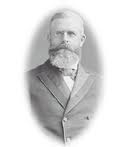 By Anne Houlding
By Anne Houlding
Sir William Mulock's father, a doctor, emigrated from Ireland to Canada in 1836. He settled on a farm near Bondhead, but the strain of trying to establish a practice in the rough backwoods of Upper Canada killed him when he was 36. William was 7 when his father died and his mother raised him on a farm she bought near Newmarket. She decided that William should be a lawyer like many of the men in her family and he was sent to study at the University of Toronto. After graduation, he worked as a junior in a law office for $80 a year and got a job as a housemaster at Upper Canada College to earn enough money to live. In 1867 he was called to the bar and began building a successful law practice.
In 1882 he entered politics and ran as a Liberal for North York where he and his family were well known. To the surprise of both Liberals and Conservatives he carried the riding, and held it for the next 23 years. During his first 14 years in Parliament he advanced quickly through the ranks of the opposition and in 1896 when the Liberals came to power, Wilfrid Laurier made him postmaster general.
All his life Mulock was a strong supporter of the British Commonwealth of Nations, believing it to be the most beneficent society the world had ever known. One of his first proposals as postmaster general was the introduction of a 2 cent postage rate between Canada and all the countries of the Empire. He believed that the increased volume of mail would not only wipe out his department's losses, it would also provide a bond of union between Canada and the rest of the Empire. In 1898 an imperial conference in London adopted his proposal for "penny postage" and within a few years his departrment's $1 million annual losses had become $1 million profit.
Mulock then introduced a plan for a publicly-owned cable across the Pacific that linked Canada with Australia and New Zealand. And in 1900 he established the first federal department of labour--one of the most important enactments in the history of the Canadian Parliament--and became Canada's first minister of labour.
A young son of one of his friends in Toronto had reported to him as postmaster general about the "sweatshop" factories that were producing uniforms for his letter-carriers. Contracts were being sub-let to families living in one room where women worked 15 hours a day earning less than 5 cents an hour. As a result of these findings, Mulock introduced a system of minimum wages and later chose the young researcher, whose name was William Lyon Mackenzie King, as his first deputy minister of labour. This was Mackenzie King's introduction to public life--in 1921 he became Prime Minister of Canada.
In 1905, Mulock retired from political life to become chief justice of the Exchequer Division of the Supreme Court of Canada. In 1923, he became Chief Justice of Ontario. And for the last 20 years of his life he was Chancellor of the University of Toronto, where one of his accomplishments was the establishment of the Banting Research Foundation, which he named after the Canadian co-discoverer of insulin.
When he died in October, 1944, his death was described as the fall of a mighty oak which had towered above all others for longer than most people could remember--he was 101 and considered the "Grand Old Man of Canada". Prime Minister Mackenzie King said that "he will be remembered as being among the makers of Canada."